The principle of operation of a solar battery: how a solar panel works and works
Effectively converting free rays of the sun into energy that can be used to power homes and other facilities is the cherished dream of many green energy apologists.
But the principle of operation of the solar battery and its efficiency are such that there is no need to talk about the high efficiency of such systems yet. It would be nice to have your own additional source of electricity. Is not it? Moreover, even today in Russia, with the help of solar panels, a considerable number of private households are successfully supplied with “free” electricity. Still don't know where to start?
Below we will tell you about the design and operating principles of a solar panel; you will learn what the efficiency of a solar system depends on. And the videos posted in the article will help you assemble a solar panel from photocells with your own hands.
The content of the article:
Solar panels: terminology
There are quite a lot of nuances and confusion in the topic of “solar energy”. It is often difficult for beginners to understand all the unfamiliar terms at first. But without this, it is unreasonable to engage in solar energy, purchasing equipment for generating “solar” current.
Unknowingly, you can not only choose the wrong panel, but also simply burn it when connecting it or extract too little energy from it.
First, you should understand the existing types of equipment for solar energy. Solar panels and solar collectors are two fundamentally different devices. Both of them convert the energy of the sun's rays.
However, in the first case, the consumer receives electrical energy at the output, and in the second, thermal energy in the form of a heated coolant, i.e. solar panels are used for home heating.
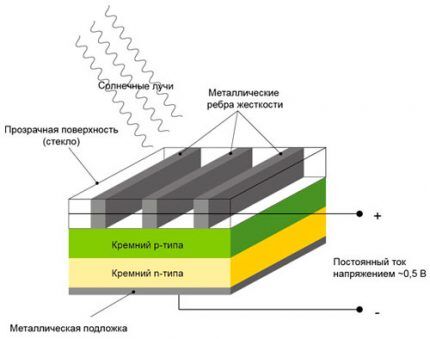
The second nuance is the concept of the term “solar battery”. Typically, the word “battery” refers to some kind of electrical storage device. Or a banal heating radiator comes to mind. However, in the case of solar batteries the situation is radically different. They do not accumulate anything in themselves.

Solar panels are designed solely to generate electric current. It, in turn, is accumulated to supply the house with electricity at night, when the sun goes below the horizon, already in the batteries additionally present in the facility’s energy supply circuit.
The battery here is meant in the context of a certain set of similar components assembled into a single whole. In fact, it is just a panel of several identical photocells.
Internal structure of a solar battery
Gradually, solar panels are becoming cheaper and more efficient.They are now used to recharge batteries in street lamps, smartphones, electric cars, private homes and on satellites in space. They even began to build full-fledged solar power plants (SPPs) with large generation volumes.

Each solar battery is designed as a block of a certain number of modules, which combine semiconductor photocells connected in series. To understand the principles of operation of such a battery, it is necessary to understand the operation of this final link in the solar panel device, created on the basis of semiconductors.
Types of photocell crystals
There are a huge number of FEP options made from different chemical elements. However, most of them are developments in the initial stages. So far, only panels made from silicon-based photovoltaic cells are currently produced on an industrial scale.

A typical photocell in a solar panel is a thin wafer of two layers of silicon, each of which has its own physical properties. This is a classic semiconductor p-n junction with electron-hole pairs.
When photons hit the photovoltaic cell between these semiconductor layers, due to the inhomogeneity of the crystal, a gate photo-EMF is formed, resulting in a potential difference and an electron current.
Silicon wafers of solar cells differ in manufacturing technology into:
- Monocrystalline.
- Polycrystalline.
The former have a higher efficiency, but the cost of their production is higher than that of the latter. Externally, one option can be distinguished from another on a solar panel by its shape.
Monocrystalline solar cells have a homogeneous structure; they are made in the form of squares with cut corners. In contrast, polycrystalline elements have a strictly square shape.
Polycrystals are obtained by gradual cooling of molten silicon. This method is extremely simple, which is why such photocells are inexpensive.
But their productivity in terms of generating electricity from solar rays rarely exceeds 15%. This is due to the “impurity” of the resulting silicon wafers and their internal structure. Here, the purer the p-silicon layer, the higher the efficiency of the solar cell from it.
The purity of single crystals in this regard is much higher than that of polycrystalline analogues. They are made not from molten, but from artificially grown solid silicon crystal. The photoelectric conversion coefficient of such solar cells already reaches 20-22%.
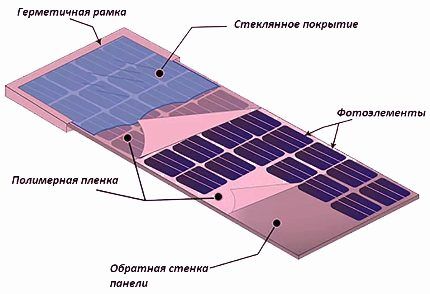
The top layer of the photocell plate facing the sun is made from the same silicon, but with the addition of phosphorus. It is the latter that will be the source of excess electrons in the pn junction system.
A real breakthrough in the field of solar energy was the development of flexible panels with amorphous photovoltaic silicon:
Operating principle of solar panel
When sunlight falls on a photocell, nonequilibrium electron-hole pairs are generated in it. Excess electrons and holes are partially transferred through the pn junction from one layer of the semiconductor to another.
As a result, voltage appears in the external circuit. In this case, a positive pole of the current source is formed at the contact of the p-layer, and a negative pole at the n-layer.
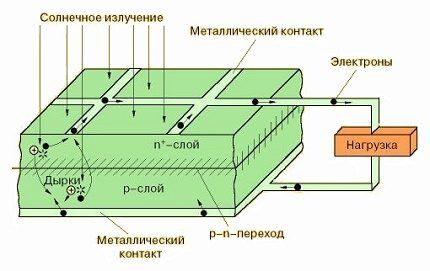
Photocells connected to an external load in the form of a battery form a vicious circle with it. As a result, the solar panel works like a kind of wheel along which electrons “run” together between proteins. And the battery gradually gains charge.
Standard silicon photovoltaic converters are single-junction cells.The flow of electrons into them occurs only through one p-n junction with a zone of this transition limited in photon energy.
That is, each such photocell is capable of generating electricity only from a narrow spectrum of solar radiation. All other energy is wasted. That is why the efficiency of FEP is so low.
To increase the efficiency of solar cells, silicon semiconductor elements for them have recently begun to be made multijunction (cascade). There are already several transitions in the new solar cells. Moreover, each of them in this cascade is designed for its own spectrum of sunlight.
The total efficiency of converting photons into electric current for such photocells ultimately increases. But their price is much higher. Here, either ease of manufacture with low cost and low efficiency, or higher returns coupled with high cost.

During operation, the photocell and the entire battery gradually heat up. All the energy that was not used to generate electric current is transformed into heat. Often the temperature on the surface of the solar panel rises to 50–55 °C. But the higher it is, the less efficiently the photovoltaic cell operates.
As a result, the same model of solar battery generates less current in hot weather than in cold weather. Photocells show maximum efficiency on a clear winter day. There are two factors at play here - a lot of sun and natural cooling.
Moreover, if snow falls on the panel, it will still continue to generate electricity.Moreover, the snowflakes won’t even have time to lie on it much, having melted from the heat of the heated photocells.
Solar battery efficiency
One photocell, even at noon in clear weather, produces very little electricity, only sufficient to operate an LED flashlight.
To increase the output power, several solar cells are combined in a parallel circuit to increase the DC voltage and in a series circuit to increase the current.
The efficiency of solar panels depends on:
- temperature of the air and the battery itself;
- correct selection of load resistance;
- angle of incidence of sunlight;
- presence/absence of anti-reflective coating;
- luminous flux power.
The lower the temperature outside, the more efficient the photocells and the solar battery as a whole work. Everything is simple here. But with load calculation the situation is more complicated. It should be selected based on the current supplied by the panel. But its value varies depending on weather factors.
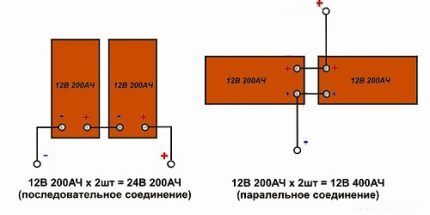
Constantly monitoring the parameters of a solar battery and manually adjusting its operation is problematic. For this it is better to use control controller, which automatically adjusts the settings of the solar panel in order to achieve maximum performance and optimal operating modes from it.
The ideal angle of incidence of the sun's rays on a solar battery is straight. However, if the deviation is within 30 degrees from the perpendicular, the efficiency of the panel drops by only about 5%.But with a further increase in this angle, an increasing proportion of solar radiation will be reflected, thereby reducing the efficiency of the solar cell.
If the battery is required to produce maximum energy in the summer, then it should be oriented perpendicular to the average position of the Sun, which it occupies on the equinoxes in spring and autumn.
For the Moscow region, this is approximately 40–45 degrees to the horizon. If the maximum is needed in winter, then the panel should be placed in a more vertical position.
And one more thing - dust and dirt greatly reduce the performance of photocells. Photons simply do not reach them through such a “dirty” barrier, which means there is nothing to convert into electricity. The panels must be washed regularly or placed so that the dust is washed off by rain on their own.
Some solar panels have built-in lenses to concentrate radiation onto the solar cell. In clear weather this leads to increased efficiency. However, in heavy clouds, these lenses only cause harm.
If a conventional panel in such a situation continues to generate current, albeit in smaller volumes, then the lens model will stop working almost completely.
The sun should ideally illuminate a battery of photocells evenly. If one of its sections turns out to be darkened, then the unlit solar cells turn into a parasitic load. Not only do they not generate energy in such a situation, but they also take it away from the working elements.
The panels must be installed so that there are no trees, buildings or other obstacles in the path of the sun's rays.
House solar power supply diagram
The solar power supply system includes:
- Solar panels.
- Controller.
- Batteries.
- Inverter (transformer).
The controller in this circuit protects both solar panels and batteries. On the one hand, it prevents the flow of reverse currents at night and in cloudy weather, and on the other, it protects the batteries from excessive charge/discharge.
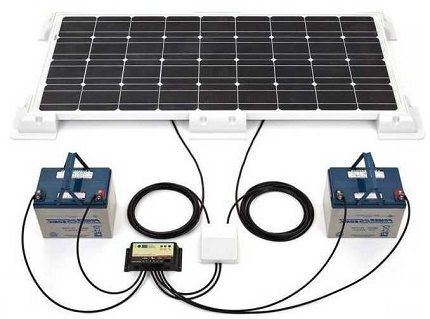
To transform direct current of 12, 24 or 48 volts into alternating current 220 volts you need inverter. Car batteries are not recommended for use in such a circuit due to their inability to withstand frequent recharging. It is best to spend money and purchase special helium AGM or flooded OPzS batteries.
Conclusions and useful video on the topic
Operating principles and solar panel connection diagrams not too difficult to understand. And with the video materials we have collected below, it will be even easier to understand all the intricacies of the functioning and installation of solar panels.
It is accessible and understandable how a photovoltaic solar battery works, in all its details:
See how solar panels work in the following video:
DIY solar panel assembly from photocells:
Each element in solar power system cottage must be chosen correctly. Inevitable power losses occur in the batteries, transformers and controller. And they must be reduced to a minimum, otherwise the already rather low efficiency of solar panels will be reduced to zero.
Did you have any questions while studying the material? Or do you know valuable information on the topic of the article and can share it with our readers? Please leave your comments in the block below.




I am toying with the idea of equipping my house with solar panels. The prospect of energy independence is tempting. I read a lot of materials on this topic. There are many pros and many cons. You need to weigh everything, because the pleasure is quite expensive. This article also did not add confidence. How to set the panel correctly to get the maximum in both summer and winter? What about care? Will you have to regularly climb onto the roof to wash the dust off the solar cells? Climbing on the roof is not an easy task. And even more so with age. Everything needs to be taken into account to ensure comfortable operation. It’s good that different nuances are explained here.
Vladimir, install solar panels and don’t hesitate. If you have about 20 thousand dollars to purchase solar panels, then you should conclude an agreement for their installation and maintenance. Professionals will install this battery at the correct angle. And you don’t have to climb the roof yourself. Young guys with a Karcher will come and wash and tighten up what is needed. I believe that solar power plants are the future.
20 thousand dollars to install panels!? They will not justify themselves in life. Plus a controller, batteries, voltage converter. How many of them will fly during the time you spend 20 thousand bucks on electricity? So consider whether it is profitable today or not.
At my dacha I installed two 200 W panels and two 120 Amp batteries. Plus a 5 kW voltage converter (peak loads 8 kW) and a controller. Everything cost about 1000 euros. There is enough heat for watering even at 35-40°. But no more. When I build a house I will add the number of panels, batteries and a controller. Install a windmill for the winter.I have no other choice. The dacha plot is not connected to the power supply. One connection will cost 1600 euros. Plus, electricity in summer cottages is expensive. Within 30 cents per 1 kW.
I understand your indignation, since the price tag of 20 thousand dollars is really a lot, even taking into account installation and commissioning work. For most of our readers, this is an exorbitant amount. But the option that you implemented, plus subsequent modernization and increasing the number of solar panels with subsequent productivity, is the optimal solution.
Regarding the windmill in winter, I agree with you here, because the productivity of solar panels in the period from November to January drops to minimum levels in our latitudes. Plus, in autumn and winter, the panels constantly need to be cleaned of dirt, leaves and snow. So a wind turbine will be an excellent additional source of alternative energy at this time of year. By the way, various options have already been discussed more than once on the forum and in articles.
Why did you delete my comment? It really hurts my eyes. They wrote here that with an extra $20,000 you can install the panels. It feels like panels are for millionaires in Russia and not for people. In Europe, everything has long been for the people. I have lived in Ireland for 16 years and was inquiring about the price of a private house. So the state also covers 30% of the cost. The price varies from 3000 to 7000 euros. But if you already put it at 6.7 thousand euros minus 30% of state coverage
Stop! Why is it necessary to install solar panels on the roof? If you have a large area in your yard, then you can easily implement ground-based placement of elements. In this case, keeping solar panels clean will be much easier, especially in winter.
The frame for placing solar panels can be made of either metal or wood. But I would recommend the first option, as it is more reliable and durable.
Why do you have prices of 20 grand, they are ripping you off like a linden there. In Ireland, a private house officially costs between 6,000 and 7,000 euros, plus the state covers 30% of the cost. I might put it
... In the column “Effectiveness ....” a gross typo by a layman - when connected in series, PV cells increase the total VOLTAGE of the installation, and when connected in parallel, the CURRENT increases. It happens... Although, I doubt the knowledge of physics of modern managers and clerks!